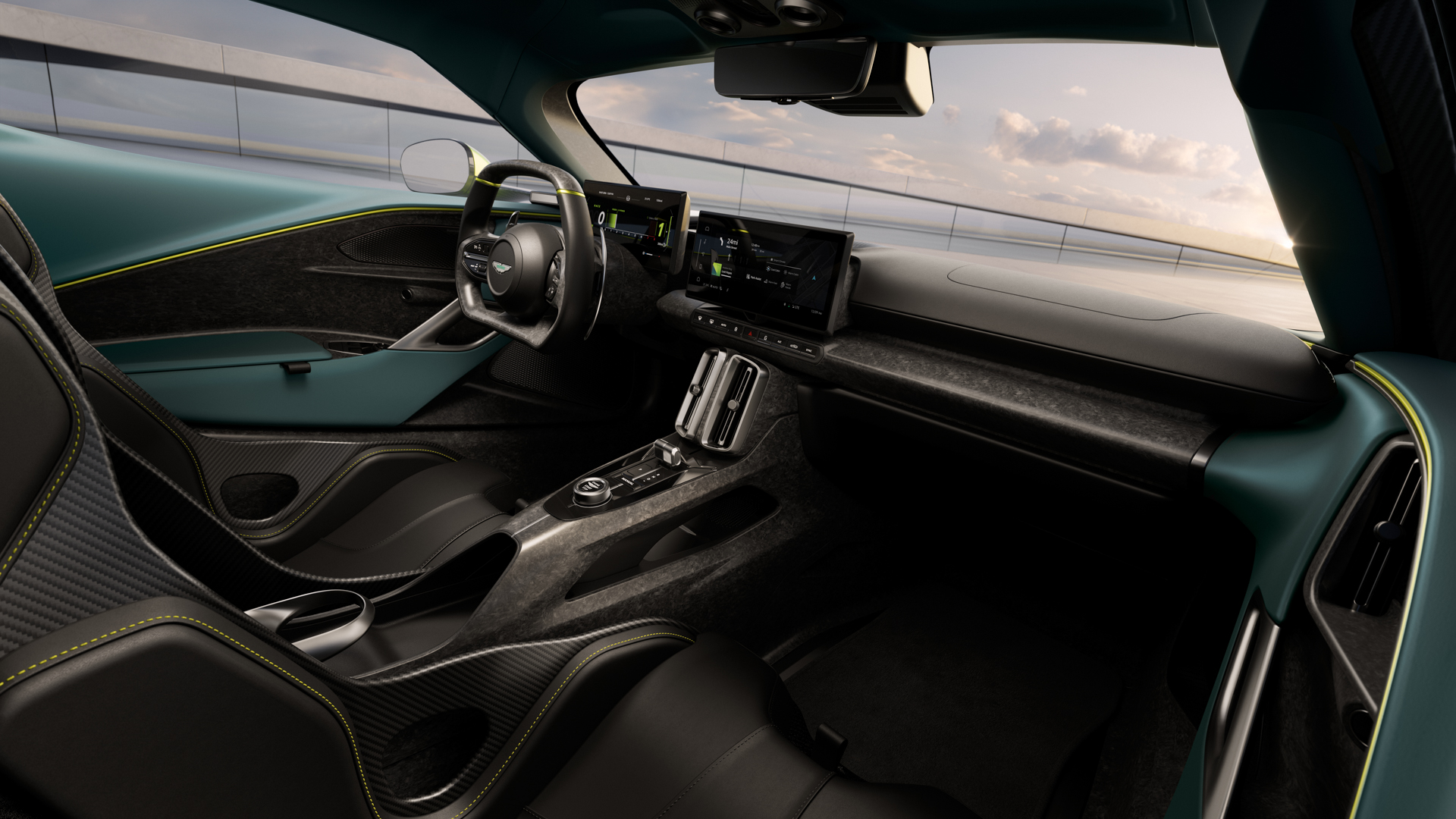

QUICK SUMMARY
Aston Martin has revealed its Valhalla is production-ready form. Powered by a plug-in hybrid system with a V8 engine and three electric motors, it produces over 1,000 horsepower and has a top speed limited to 217 mph.
Limited to 999 examples, the Valhalla goes into production in the second half of 2025.
Over five years on from the first concept – and three years since a major redesign – Aston Martin is finally ready to put its Valhalla supercar into production.
This is a big deal for Aston, since the Valhalla is its first series-production mid-engined supercar (albeit one limited to 999 examples), its first to use a new, bespoke V8 hybrid engine, and its first plug-in hybrid, complete with electric-only drive mode.
The Valhalla is also the first car to use Aston Martin’s new eight-speed dual-clutch gearbox, and the first to combine its engine with three electric motors for all-wheel-drive and torque vectoring across the front axle.
In other words, this car is a very big deal for Aston Martin. It’s the car that will continue Aston’s mission to leave behind rivals like Bentley, Porsche and Maserati, and instead take on Ferrari, McLaren and Lamborghini. You might also recognise the car from the most recent James Bond film, No Time To Die, where it lurked stationary in the background.

Due to go into production in the second half of 2025, the Valhalla is powered by a bespoke, flat-plane-crank, 4.0-litre, twin-turbo V8 engine. That produces 828 PS (917 horsepower) on its own, but it’s also joined by three electric motors fed by a high-voltage battery, which deliver an additional 251 PS. Total output is 1,079 PS and torque stands at 1,100 Nm.
Two of the three motors drive the front axle, where they facilitate torque vectoring, act as the car’s reverse gear, help slow the car using regenerative braking, provide torque fill to supplement the engine during gear changes, and are used for the Valhalla’s EV-only drive mode. The third motor is part of the new, eight-speed gearbox.
Aston says the Valhalla can accelerate to 62 mph in 2.5 seconds and has an electronically-limited top speed of 217 mph. The battery can deliver up to 8.7 miles of EV-only range, or drive the car at up to 87 mph with the engine switched off.
Sign up to the T3 newsletter for smarter living straight to your inbox
Get all the latest news, reviews, deals and buying guides on gorgeous tech, home and active products from the T3 experts
As well as being quick in a straight line, Aston Martin says the Valhalla can generate over 600 kg of downforce from 149 mph. It features active front and rear wings, with the latter having a Formula One-style DRS system to reduce drag at high speed, and it also doubles as an air brake. Switch the car into race mode and the rear wing raises by 255 mm, while a concealed active front wing also engages for extra downforce.

The Valhalla features a carbon fibre monocoque, incorporating a bespoke carbon tub that weighs 74.2 kg and carbon body panels. Total weight is a claimed 1,655 kg, while Aston says the power-to-weight ratio is 652PS per 1,000 kg.
Given Aston Martin the supercar maker is closely tied to Aston Martin the Formula One team, the Valhalla benefits from motorsport-derived pushrod-style front suspension system with inboard-mounted dampers, plus carbon ceramic brakes with massive 410 mm discs at the front and 390 mm discs at the rear. These act alongside the air brake function of the rear wing and the front motors’ energy recovery system to slow the car.
Open the forward-hinged dihedral doors and the interior features a carbon, F1-inspired steering wheel and F1-style seating position, with raised pedals and one-piece carbon fibre seats.

The rest of the cabin is all-new, and showcases a new interior design language from Aston Martin. Recycled and forged carbon fibre features on the dashboard and centre console, while a pair of digital displays act as the instrument panel and infotainment system, complete with Bowers & Wilkins speakers. Below the central screen are a set of physical buttons for key functions, and a gear selector and start/stop button sit prominently in the centre of the cabin.
Expected to cost from around £600,000 to £700,000, the Aston Martin Valhalla is limited to 999 examples and is due to go into production in the second half of 2025. As ever, Aston’s Q department will offer a wide range of customisable options, including a choice of six bespoke livery themes said to be “inspired by Aston Martin’s heritage in various motorsport formula.”
Alistair is a freelance automotive and technology journalist. He has bylines on esteemed sites such as the BBC, Forbes, TechRadar, and of best of all, T3, where he covers topics ranging from classic cars and men's lifestyle, to smart home technology, phones, electric cars, autonomy, Swiss watches, and much more besides. He is an experienced journalist, writing news, features, interviews and product reviews. If that didn't make him busy enough, he is also the co-host of the AutoChat podcast.
-
 Quietly, this Chinese brand built one of the most comprehensive health wearable systems in the world
Quietly, this Chinese brand built one of the most comprehensive health wearable systems in the worldWith the launch of the Distributed Super-Sensing Module, Huawei returns to the top of the wearable market in top form
By Matt Kollat
-
 6 offbeat products from premium outdoor and fitness labels you didn't know existed
6 offbeat products from premium outdoor and fitness labels you didn't know existedWho would have thought these products existed?
By Matt Kollat
-
 The new Aston Martin Vantage Roadster is drop-top perfection
The new Aston Martin Vantage Roadster is drop-top perfectionHave we already found the most beautiful car of 2025?
By Alistair Charlton
-
 Aston Martin DB12 Goldfinger Edition contains real gold, but no ejector seat
Aston Martin DB12 Goldfinger Edition contains real gold, but no ejector seatForget The Man with The Golden Gun, this is the car with the golden gearstick
By Alistair Charlton
-
 Aston Martin Vanquish is a new V12 flagship to take on Ferrari
Aston Martin Vanquish is a new V12 flagship to take on FerrariLong live the V12
By Alistair Charlton
-
 Aston Martin DBX gets a massive tech and audio update
Aston Martin DBX gets a massive tech and audio updateWith DB12-level entertainment and even better performance, this is no ordinary SUV
By Mat Gallagher
-
 Aston Martin DB12 Volante first drive: topless tourer goes like a supercar
Aston Martin DB12 Volante first drive: topless tourer goes like a supercarCoupe or convertible? Aston's muscular DB12 gets the Volante treatment in time for summer
By Alistair Charlton
-
 Aston Martin Vantage is a massive upgrade on its predecessor
Aston Martin Vantage is a massive upgrade on its predecessorAston isn’t mucking about: New Vantage is a whopping 30 percent more powerful than before
By Alistair Charlton
-
 Apple teams with Porsche and Aston Martin for next-gen CarPlay experience
Apple teams with Porsche and Aston Martin for next-gen CarPlay experienceApple will CarPlay a starring role in upcoming infotainment offerings
By Leon Poultney
-
 Aston Martin DB12 first drive: the double agent
Aston Martin DB12 first drive: the double agentThis super tourer continues the legacy with a level of ultra-luxury and high performance that may be difficult to follow
By Mat Gallagher